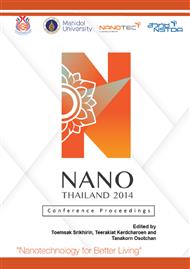p.106
p.110
p.117
p.123
p.131
p.135
p.139
p.146
p.153
Classification of Fertilizer Solutions by Micro-Volume Voltammetric Electronic Tongue with Two Sensing Electrodes
Abstract:
A micro-volume electronic tongue based on cyclic voltammetry with two sensing electrodes (gold and carbon) and a platinum pseudo-reference electrode is proposed to classify fertilizers and monitor fertilizer uptakes. The electronic tongue has been employed to classify three different types of commercial fertilizers and their mixture. The nutrient uptake of Dracaena Sanderiana (D. Sanderiana) planted in crystal soil with the mixture fertilizer was monitored by sampling the fertilizer solutions with the electronic tongue over a period of one week. The contents of macronutrients in the solutions were also analyzed by the standard spectroscopic techniques for comparison. A good agreement is obtained between the relative uptakes of phosphate and potassium from the electronic tongue analysis and those from the standard analytical techniques.
Info:
Periodical:
Pages:
131-134
Citation:
Online since:
December 2015
Price:
Сopyright:
© 2016 Trans Tech Publications Ltd. All Rights Reserved
Share:
Citation:


